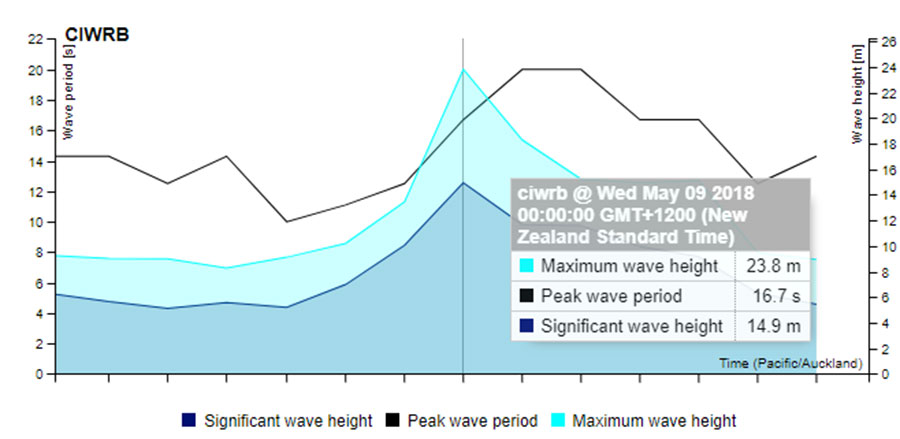
The MetOcean Solutions wave buoy moored in the Southern Ocean recorded a massive 23.8 m wave. Image: MetOcean
Every three hours, a solar-powered buoy anchored off New Zealand’s Campbell Island flicks on for 20 minutes. It bobs around in the Southern Ocean recording wave-heights for those few minutes to send back to researchers who measure these kinds of things. And on the night of May 9th, those researchers looked at the numbers that little buoy was sending back and saw something incredible: the largest wave ever recorded in the Southern Ocean. “This is a very exciting event,” MetOcean Solutions senior oceanographer Dr Tom Durrant said. “To our knowledge, it is the largest wave ever recorded in the southern hemisphere.”
MetOcean’s buoy, which sits around 400 miles south of New Zealand, isn’t a stranger to very large waves. The Southern Ocean, as you well know, is the home field for more than a few giant storms. “The persistent and energetic wind conditions here create enormous fetch for wave growth, making the Southern Ocean the engine room for generating swell waves that then propagate throughout the planet,” said Durrant. “Indeed, surfers in California can expect energy from this storm to arrive at their shores in about a weeks’ time.” Dr Durrant said.
So just how big was this wave? Well, according to that little buoy, it was a staggering 78 feet tall. The previous record for the area was 63 feet, which was recorded last year. Now, I know what you’re thinking. “Seventy-eight feet?” you think. “That’s around the size of the world-record for biggest wave ever surfed! Surely there must be bigger waves in the Southern Ocean!” You think right. You think right for two main reasons. First, that 78-footer in the middle of the Southern Ocean was an open ocean wave. That means its driven entirely by fetch. “[This] storm is the perfect example of waves generated by the easterly passage of a deep low-pressure system with associated wind speeds exceeding 65 knots,” Dr Durrant continued. “Such storms are frequent and can occur at any time of the year, which differs from the high-latitude northern hemisphere storms that only occur in winter.”
You think right for two main reasons. First, that 78-footer in the middle of the Southern Ocean was an open ocean wave. That means its driven entirely by fetch. “[This] storm is the perfect example of waves generated by the easterly passage of a deep low-pressure system with associated wind speeds exceeding 65 knots,” Dr Durrant continued. “Such storms are frequent and can occur at any time of the year, which differs from the high-latitude northern hemisphere storms that only occur in winter.”
Second, it’s not a breaking wave—it’s just a massive, rolling mountain of energy. One can only imagine the size of it if it were to make its way over a reef or into a point. Second, it’s very likely that much larger waves rolled around during the storm that produced the record-setting one, but since the MetOcean buoy only records for 20 minutes every three hours, it probably simply missed them. “It is likely that the peak heights during this storm were actually much higher,” Dr Durrant explained, “with individual waves greater than 25m being possible as the wave forecast for the storm show larger wave conditions just north of the buoy location.”
While it may be a record for the Southern Ocean, it’s not a world record. That distinction goes to the North Atlantic from 2013. The World Meteorological Organization uses something called “significant wave height” to characterize the sea state. In short, it’s the average height of the highest third of all the waves measured. It’s a way of measuring the ferocity of the storm instead of one single wave. The Southern Ocean storm’s significant wave height came in at around 50 feet, while the 2013 North Atlantic storm was a staggering 62 feet.

